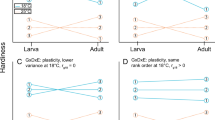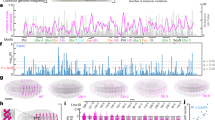Abstract
WHAT functional component of an animal is most sensitive to heat? We discuss here two reasonable possibilities which have quite different implications. If heat injury is mediated primarily by enzyme inactivation, then natural selection may well have brought a large number of enzymes to the point where a given duration at a high temperature should cause a comparably critical loss in the activity of each. If this is the case, then selection for increased heat resistance would require simultaneous responses at many enzyme loci, as one sensitive enzyme would make the increased stability of the others worthless. In genetic terms, the sensitive enzyme would be epistatic to the rest. On the other hand, if cell or tissue damage is the first effect of excessive heat, then heat resistance is likely to be a quantitative characteristic, with a considerable additive genetic component. Selection for increased thermostability should be possible. In either case, selection for reduced heat resistance should be relatively rapid, as temperature-sensitive mutants would, as a class, probably be frequent enough to dominate the situation.
This is a preview of subscription content, access via your institution
Access options
Subscribe to this journal
Receive 51 print issues and online access
$199.00 per year
only $3.90 per issue
Buy this article
- Purchase on Springer Link
- Instant access to full article PDF
Prices may be subject to local taxes which are calculated during checkout
Similar content being viewed by others
References
Waddington, C. H. Evolution 7, 118–126 (1953).
Hosgood, S. M. W. & Parsons, P. A. Experientia 24, 727–728 (1968).
Lindsley, D. L. & Grell, E. H. Genetic Variations of Drosophila melanogaster (Carnegie Institution of Washington, Washington, DC, 1968).
Milkman, R. Science 131, 225–226 (1960).
Milkman, R. Adv. Genet. 15, 55–114 (1970).
Author information
Authors and Affiliations
Rights and permissions
About this article
Cite this article
MORRISON, W., MILKMAN, R. Modification of heat resistance in Drosophila by selection. Nature 273, 49–50 (1978). https://doi.org/10.1038/273049b0
Received:
Accepted:
Issue Date:
DOI: https://doi.org/10.1038/273049b0
This article is cited by
-
Quantitative trait loci for thermotolerance phenotypes in Drosophila melanogaster
Heredity (2006)
-
Direct and correlated effects of selection on flight after exposure to thermal stress in Drosophila melanogaster
Genetica (2006)
-
The role of fertility restoration in the maintenance of the inversion In(2L)t polymorphism in Drosophila melanogaster
Heredity (1999)
-
The direct response of Drosophila melanogaster to selection on knockdown temperature
Heredity (1999)
-
Estimating heritability in a threshold trait: heat-shock tolerance in Drosophila buzzatii
Heredity (1997)
Comments
By submitting a comment you agree to abide by our Terms and Community Guidelines. If you find something abusive or that does not comply with our terms or guidelines please flag it as inappropriate.



